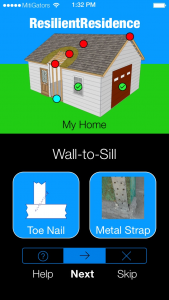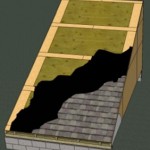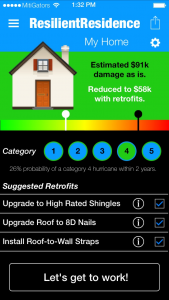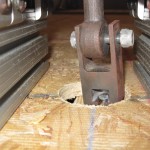Resilient Residence (SURF Pilot Survey)
 Background: Due to the recent natural hazard events, and the well-known vulnerability of a number of structures built prior the release of the Florida Building code in 2001. Researchers at the University of Florida are even more committed to enhance the performance of the structures when facing wind hazard.
Background: Due to the recent natural hazard events, and the well-known vulnerability of a number of structures built prior the release of the Florida Building code in 2001. Researchers at the University of Florida are even more committed to enhance the performance of the structures when facing wind hazard.
Lately, we all witnessed the tremendous destructive power that hurricanes release through wind, flood or surge. A category 5 hurricane, one as big as Irma, can easily rip off roofs and crush walls. Without doubt Florida will always face the power of wind over and over again, but what have homeowners done to reduce the risk?
The adoption of mitigation actions for vulnerable buildings has been promoted by State Officials and NGOs. Small changes such as improving roof to wall connections, installing shutters on windows or braces in the garage door can make a big difference in the expected level of damage.
Project:
Researchers at the University of Florida developed a mobile app to provide personalized information of mitigation actions. However, the delivered information must fit the homeowners’ concerns. Not only do we want to show cost benefit numbers, but we also want to clarify any homeowners’ concerns. The ResilientResidence app (ResRe) is your one-stop hub for all the information you need to protect you and your family from wind disasters. Through an intuitive, step-by-step process, it collects the critical information on your home, giving you helpful hints along the way. This information is then used to provide your personalized risk – based upon an established, science-based catastrophe model known as HAZUS-MH Hurricane Model
Pilot study SURF:
It is important to test the effectiveness of the information that ResRe provides. The effectiveness test uses retrofit decision scenarios. A scenario provides general information about a particular homeowner who has to make a decision about protective measures. Participants will answer few questions that follow this scenario.
Currently we are in the pilot phase. We are interested in the time and difficulty of our basic scenario, so the design of the experiment will be developed more efficiently in the future.
Link to to the Pilot survey:
It will be available soon
More about his project:
 Wind Uplift Capacity of Foam-Retrofitted Roof Sheathing Subjected to Water Leaks
Wind Uplift Capacity of Foam-Retrofitted Roof Sheathing Subjected to Water Leaks
Failure of roof sheathing during extreme wind events is a common failure mode in residential roofs. The majority of hurricane-related losses are sustained by residential homes and 95% of these are from failures within roof-systems (Baskaran, Dutt, 1997). Inadequate fastening of wood sheathing to roof framing members is the most common failure mode. Roof sheathing failure causes major losses for two primary reasons: (1) the loss of diaphragm action weakens the lateral stability of the roof, leading to roof failure and progressive collapse of the building; and (2) openings made in the roof can allow water to intrude which severely damages interior components and building contents. Despite enhanced building code provisions that have improved the construction of newer homes, over 80% of the existing residential housing stock in these hurricane-prone regions were built before any building code changes (Datin, Prevatt et al., 2011). Thus, a significant portion of the existing housing stock remains vulnerable to these damages. Therefore it is beneficial to identify viable retrofit options to improve the uplift capacity of these vulnerable roof systems.
David O. Prevatt, Kenton McBride, David B. Roueche, and Forrest J. Masters, “Wind Uplift Capacity of Foam-Retrofitted Roof Sheathing Subjected to Water Leaks,” ATC-SEI, Miami, Fl, 2012, pp. 305-306.
 High Speed Wind Uplift Research on Green Roof Assemblies
High Speed Wind Uplift Research on Green Roof Assemblies
The purpose of this research project was to develop wind resistance tests and to evaluate the characteristic response of green roof systems to extreme winds. The two-year study
investigated two types of green roof systems; modular tray green roofs and built-in-place green roof systems.
Tuan D. Vo, David O. Prevatt, G.A. Acomb, N.K. Schild, and K.T. Fischer, “High Speed Wind Uplift Research on Green Roof Assemblies,” Cities Alive, Chicago, IL, 2012, pp. 1-11
Effects of Installation Method on Nail Withdrawal Capacities
Sheathing attachment is extremely important in residential structures. The roof is usually the first thing to fail in a windstorm and once this happens the remaining structure is more unstable. Wood residential buildings account for 60% of all damages in wind storms (Sparks, 1991) and 95% of residential economic losses are from failures associated with the roof (Baskaran, 1997). These failures are due in part to inadequate strength in fasteners (primarily nails) attaching wood sheathing to the wood rafter (Shreyans, 2012). The objective of this current study is to evaluate the effect of the nail installation method on the nail withdrawal capacity.
Ashlie Kerr, Shelly Dean, and David O. Prevatt (2012). Effects of installation method on nail withdrawal capacities. Manuscript submitted for publication, Engineering School of Sustainable Infrastructure and Environment, University of Florida, Gainesville, FL.











